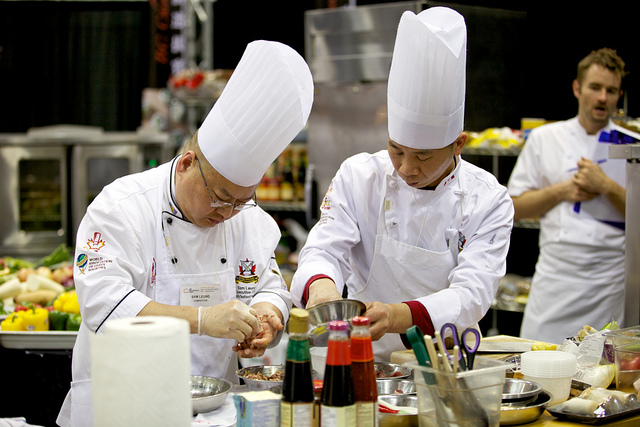Chinese cuisine and world heritage

Chinese chefs prepare dishes for a local food service expo in the Province of British Columbia, Canada. Chinese cuisines are very popular on international dining tables, but a series of problems still hinder China's application for the world heritage list.
There are currently six cuisines on UNESCO’s Representative List of the Intangible Cultural Heritage of Humanity, but that number may soon grow. Belgium, Germany and other countries are eagerly preparing to apply for world intangible heritage status for their domestic special dishes. As a traditional agricultural country, China has a profound history of food culture. So what things should China consider when applying for world heritage status for its various cuisines?
The cooking skills involved, rare food materials and quantity of dishes are not the most significant elements considered by the assessment experts. Beatrice Kaldun, a Culture Programme Specialist, at the UNESCO Beijing Office, said that UNESCO emphasizes consumption by the public as a key criterion and focuses on how the dish is spread.
Wu Bing’an, a famous Chinese folklorist and vice chairman of the National Intangible Cultural Heritage Protection Committee of Experts holds the same opinion. He chose washoku and Korean kimchi as examples and indicated that both of them are important foods that have been tailored to popular tastes. Wu said that washoku, a traditional Japanese cuisine, is quite different from the expensive dishes in restaurants, but was originally made for the celebration of New Year by common people.
Kimchi is an essential element on the dining table of each Korean household. After every autumn harvest, Koreans make kimchi together with their family and neighbors. The communal aspects of this food have been made apparent.
UNESCO also aims to promote a scientific and healthy diet through the selection of various cuisines into the world heritage list. Modern people’s eating habits and the environment face numerous challenges. Some traditional but endangered food cultures have valuable things to offer modern cultures. For example, the Mediterranean diet was included in the list because of its scientific and healthy food selection standards and cooking methods.
However, Chinese cuisines are still not represented in the world heritage list. Wu said that because six dishes have been included in the list, China faces a lot of pressure. As a big traditional agricultural country with a lot of food cultures, China has both responsibilities and obligations to contribute its rich food culture heritage to the world.
But Chinese cuisines face a series of problems in applying for the world heritage list. Chinese food culture has rich local colors and forms different kinds of cuisines. After thousands of years’ accumulation, royal dishes and the culture of dinner ceremonies have been a significant constituent part of Chinese food culture. Although major Chinese cooking styles and royal dishes are highly recognized at home, they cannot well embody the principle of sharing to receive recognition from international society, or represent the main features of Chinese food culture, whose main body is its hundreds of millions of people.
However, localized forms of Chinese food have unique characteristics. In contrast to feasts, these local foods are much closer to the everyday lives of ordinary people, and can thus preserve a nation’s cultural memories. So, when combined with festival traditions, these local foods are more likely to achieve success in this respect.
Chinese food culture can be roughly divided into two parts: north China’s wheat culture and south China’s rice culture. The Chinese Spring Festival’s Eve dinner collectively represents a whole year’s bumper harvest. It not only well integrates two different eating styles, but also reflects Chinese dishes’ various elements. Meanwhile, it is also a nationwide family reunion dinner. Those traditions and folk customs based on the Spring Festival’s Eve dinner are typical examples showing the public’s involvement in sharing Chinese food culture.
